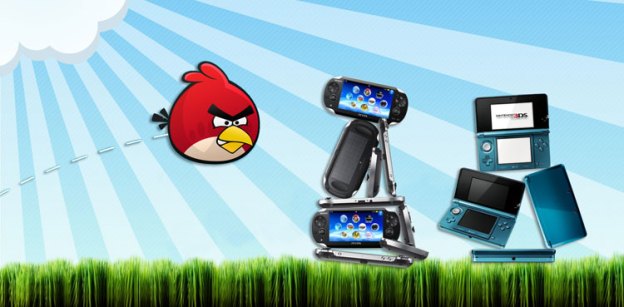
A few years ago, mobile gaming used to be dominated by two companies: Nintendo and Sony. Nintendo had its seemingly unstoppable juggernaut of its Nintendo DS handheld, which in turn built on the company’s Game Boy empire. Sony, as always, aimed at the high end with its PlayStation Portable, and while the platform never ignited the way Nintendo’s did, it still garnered fans for the quality of its game play and (occasionally) for its media capabilities.
The money was good: consumers were accustomed to paying in the neighborhood of $200 every few years for a mobile gaming device, and around $40 retail for individual game titles.
However, these days Nintendo and Sony are finding themselves reduced to also-rans amongst the onslaught of Android and iOS devices: smartphones, portable media players, and tablets. These devices have most of the essential capabilities of portable gaming devices — touch screens, motion sensors, accelerometers, and fast graphics — coupled with messaging, Internet access, and an explosion in widely available games and content.
Can Sony and Nintendo survive in a portable gaming world dominated by smartphones and tablets?
How bad is it?
Pretty bad. A new analysis from Flurry Analytics paints a grim revenue picture for Sony and Nintendo compared to the combined market power of

Admittedly, the market for portable games has grown in that time, meaning that not all of the gains in iOS and
What about units? The picture is even more frightening. Despite a years-long head start, the raw unit sales of both the Nintendo DS platform and Sony PSP have both been surpassed by

** Includes Sony PSP and PSPgo
*** Estimates primarily from data published by Gartner and NPD; no consistent data for Q3 2011 yet
**** Includes iPhone and iPad; omits iPod touch
It should be noted that the figures used here for
The upshot: the figures in these charts definitely under-represent iOS unit sales, and potentially under-represent
Even so, the picture for Sony and Nintendo over the last four quarters is troubling:

This is, of course, an apples-to-oranges comparison. While it’s reasonable to assume nearly everyone who buys a portable gaming device is interested in gaming, the same cannot be said of
But clearly Sony and Nintendo have their work cut out for them. For
What are Sony and Nintendo doing?
Neither Sony nor Nintendo are exactly sitting on their hands while mobile operating systems run away with the portable gaming market. However, it’s not clear either company has come up with a strategy that will preserve its existing platform.
Both Sony and Nintendo are famously insular about their gaming businesses — just ask anybody who wanted to run Linux or homebrew on their PS3s. However, Sony has just launched a private beta of a software development kit (SDK) for what it’s terming the PlayStation Suite. Although its geared at the enabling developers to create titles for the upcoming PlayStation Vita, the SDK also aims to support “PlayStation Certified” products. For now, that includes Sony Ericsson’s Xperia Play phone and Sony’s in talks with other Android device makers about offering PlayStation Suite on more devices. However, it’s not yet clear whether PlayStation Suite titles will fill the needs of serious gamers, or even provide good enough performance for everyday titles. Although developers can make their own cames in C# (and host their development on Windows XP or Windows 7), the games run in a virtual machine on
Meanwhile, Nintendo seems to be sticking to its guns, doubling down on its Nintendo 3DS handheld and touting forthcoming titles. Despite an announcement that the company would develop a Pokemon game for iOS and
The long term
Serious gamers will always point out that, with rare exceptions,
However, it’s clear that a large (and growing) portion of the consumer marketplace is satisfied with general purpose smartphones and tablets—and while they aren’t all using them for gaming, enough of them are that portable gaming platforms are seeing both their unit sales decline and their software revenue drop significantly. If that trend continues, third-party game developers will be forced to follow the money. Unfortunately for portable gaming, that’s towards smartphones and tablets.
Editors' Recommendations
- Epic still plans to bring its Games Store to iOS and Android this year
- Fortnite is coming back to iOS, but Epic Games still isn’t happy about it
- Sony’s new PlayStation earbuds are a perfect match — for my Nintendo Switch
- You can still get a Thunder Shotgun in Fortnite Chapter 4 Season 2. Here’s how
- This mobile fitness game will turn your daily walk into an RPG


